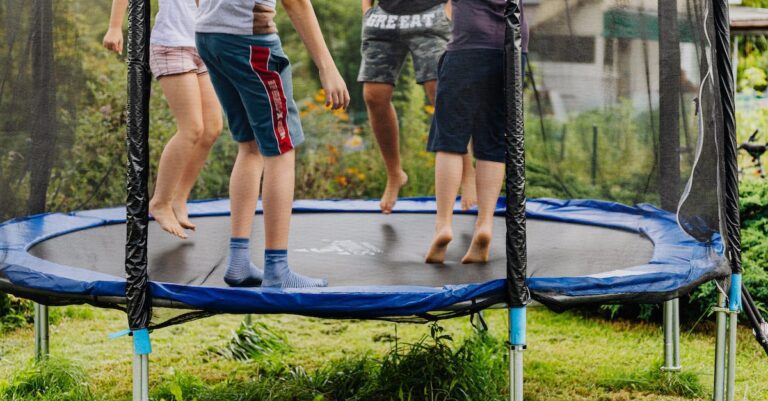The Ultimate Guide to Trampolining Safety: Tips for a Fun and Injury-Free Experience
Introduction
What is trampolining?
Trampolining is a recreational activity that involves jumping and performing acrobatic movements on a trampoline. It is a popular form of exercise and entertainment for people of all ages. Trampolining provides numerous health benefits, including improved cardiovascular fitness, increased muscle strength and coordination, and enhanced balance and agility. However, it is important to prioritize safety while trampolining to prevent injuries. This article will provide valuable tips and guidelines to ensure a fun and injury-free trampolining experience.
Benefits of trampolining
Trampolining offers a wide range of benefits for both children and adults. Not only is it a fun and exciting activity, but it also provides a great way to improve cardiovascular fitness and coordination. Jumping on a trampoline can help strengthen muscles, improve balance, and enhance overall body strength. Additionally, trampolining can be a great stress-reliever and can boost mood by releasing endorphins. Whether you’re looking to get in shape, have some fun, or simply enjoy the thrill of bouncing in the air, trampolining is an excellent choice that offers numerous physical and mental benefits.
Importance of trampolining safety
Trampolining safety is of utmost importance to ensure a fun and injury-free experience. Whether you’re a beginner or an experienced jumper, understanding and following safety guidelines is crucial. By prioritizing safety, you can minimize the risk of accidents and enjoy the many benefits of trampolining. Proper supervision, using a safety net, and avoiding risky maneuvers are just a few ways to enhance trampoline safety. Remember, a safe trampolining experience is the key to a lifetime of enjoyment and physical activity.
Choosing the Right Trampoline
Size and shape considerations
When it comes to trampolining, size and shape considerations are important factors to keep in mind. The size of the trampoline should be suitable for the available space in your backyard or indoor area. It is crucial to ensure that there is enough room for the trampoline to be safely installed and used. Additionally, the shape of the trampoline can also impact the overall experience. Rectangular trampolines are known for providing a higher bounce and are often preferred by experienced trampolinists, while round trampolines are more commonly used for recreational purposes. Ultimately, the size and shape of the trampoline should be chosen based on your personal preferences and the intended use. By considering these factors, you can ensure a safe and enjoyable trampolining experience for yourself and others.
Weight capacity
The weight capacity of a trampoline is an important factor to consider for a safe and enjoyable experience. It refers to the maximum weight that the trampoline can safely support. Exceeding the weight capacity can lead to structural damage and increased risk of injuries. It is crucial to adhere to the weight restrictions specified by the manufacturer to ensure the trampoline’s longevity and prevent accidents. Before using a trampoline, always check the weight capacity and make sure it can accommodate the intended users. If multiple people will be using the trampoline simultaneously, their combined weight should not exceed the maximum limit. By following the weight capacity guidelines, you can have a worry-free trampolining experience and minimize the risk of accidents.
Safety features to look for
When it comes to trampolining, safety should always be the top priority. To ensure a fun and injury-free experience, it is important to look for certain safety features when purchasing a trampoline. One key feature to consider is a sturdy and durable frame that can withstand the weight and impact of multiple jumpers. Additionally, a safety enclosure net is essential to prevent users from falling off the trampoline. It is also advisable to choose a trampoline with padded springs and a thick jumping mat to minimize the risk of injury. By investing in a trampoline with these safety features, you can enjoy the thrill of bouncing while keeping yourself and your loved ones safe.
Setting Up a Safe Trampoline Area
Selecting the right location
When it comes to selecting the right location for trampolining, there are a few key factors to consider. First and foremost, you want to choose a flat and level surface that is free from any obstructions such as trees, fences, or other structures. This will help ensure a safe and enjoyable trampolining experience. Additionally, it’s important to select an area that provides enough space around the trampoline for users to safely jump and land. Ideally, there should be a minimum clearance of at least 10 feet on all sides. Lastly, consider the accessibility of the location. You want to choose a spot that is easily accessible for both participants and any necessary equipment, such as a ladder or safety net. By carefully selecting the right location, you can set the foundation for a fun and injury-free trampolining experience.
Preparing the ground
When it comes to trampolining safety, preparing the ground is an essential step. Before setting up your trampoline, make sure the area is clear of any obstacles such as rocks, branches, or toys. Level the ground to ensure a stable and even surface. It’s also important to consider the surrounding environment – keep the trampoline away from trees, fences, or any other structures that could pose a risk. By taking these precautions, you can create a safe and enjoyable trampolining experience for everyone.
Installing safety net and padding
When it comes to trampolining safety, installing a safety net and padding is crucial. These two elements provide an extra layer of protection and help prevent accidents and injuries. The safety net acts as a barrier, preventing users from accidentally falling off the trampoline and onto the ground. It is important to ensure that the safety net is securely attached and properly maintained. Additionally, padding around the trampoline’s edges and springs helps to minimize the risk of impact injuries. This padding should be thick and durable, capable of absorbing the force of any accidental falls. By installing a safety net and padding, trampolinists can enjoy a fun and injury-free experience with peace of mind.
Basic Trampolining Safety Rules
Supervision and age restrictions
When it comes to trampolining safety, supervision and age restrictions play a crucial role. It is important to ensure that there is always adult supervision present when children are using a trampoline. This helps to prevent any potential accidents or injuries and allows for immediate assistance if needed. Additionally, it is essential to follow the age restrictions set by the trampoline manufacturer. These restrictions are in place to ensure that users are physically capable of safely using the trampoline. By adhering to these guidelines, you can help create a fun and injury-free trampolining experience for everyone involved.
Proper attire and accessories
When it comes to trampolining, wearing the proper attire and accessories is essential for a safe and enjoyable experience. It is important to wear comfortable and fitted clothing that allows for ease of movement while bouncing on the trampoline. Loose or baggy clothing can get caught in the springs or the frame, increasing the risk of accidents. Additionally, wearing appropriate footwear, such as athletic shoes with good grip, can help prevent slipping and provide better stability. It is also recommended to remove any jewelry or accessories that could pose a risk of getting tangled or causing injury. By following these guidelines and ensuring proper attire and accessories, you can minimize the risk of accidents and maximize the fun of trampolining.
Warm-up exercises
Before you start bouncing on the trampoline, it is crucial to warm up your body with some exercises. Warm-up exercises help to prepare your muscles and joints for the physical activity ahead, reducing the risk of injury. Some effective warm-up exercises for trampolining include light jogging or jumping jacks to get your heart rate up, stretching to improve flexibility, and gentle bouncing on the trampoline to gradually increase your body’s readiness. By incorporating these warm-up exercises into your trampolining routine, you can ensure a fun and injury-free experience.
Jumping Techniques and Safety Tips

Bouncing and landing techniques
When it comes to trampolining, mastering the bouncing and landing techniques is crucial for a safe and enjoyable experience. Properly executing these techniques not only prevents injuries but also enhances your performance. To start, make sure you maintain a balanced and centered position on the trampoline mat. This will help you control your movements and reduce the risk of falling off. When bouncing, remember to use your legs to generate the upward force and keep your body relaxed. As you land, aim to land with your feet first, bending your knees to absorb the impact. This distributes the force evenly throughout your body and minimizes stress on your joints. By practicing and perfecting these techniques, you can have a fun-filled and injury-free trampolining adventure.
Avoiding dangerous stunts
When it comes to trampolining, it is important to prioritize safety and avoid engaging in dangerous stunts. While it may be tempting to attempt flips, somersaults, or other acrobatic moves, these can lead to serious injuries if not executed properly. Instead, focus on mastering basic trampoline skills and gradually progress to more advanced tricks under the supervision of a trained instructor. Always follow the manufacturer’s guidelines and ensure that the trampoline is in good condition before use. By taking these precautions, you can enjoy a fun and injury-free trampolining experience.
Jumping with multiple people
Jumping with multiple people on a trampoline can be a thrilling and enjoyable experience, but it is important to prioritize safety to prevent any accidents or injuries. Before jumping with others, it is crucial to ensure that the trampoline is designed for multiple users and has a weight capacity that can accommodate the combined weight of all participants. Additionally, it is essential to establish clear rules and guidelines for jumping, such as avoiding rough play, maintaining a safe distance from each other, and taking turns to prevent collisions. By following these precautions, everyone can have a fun and injury-free trampolining experience together.
Common Trampolining Injuries and Prevention
Sprains and strains
Sprains and strains are common injuries that can occur while trampolining. A sprain is a stretching or tearing of the ligaments, which are the tough bands of tissue that connect bones together. Strains, on the other hand, are injuries to the muscles or tendons, which are the fibrous tissues that connect muscles to bones. Both sprains and strains can happen when landing awkwardly on the trampoline or when performing high-impact movements. To prevent these injuries, it is important to warm up properly before trampolining, use proper technique and form, and avoid attempting advanced maneuvers without proper training and supervision.
Fractures and dislocations
Fractures and dislocations are among the most common injuries that can occur while trampolining. These types of injuries can happen when landing improperly or colliding with another jumper. Fractures are breaks in the bones, while dislocations occur when the bones in a joint are forced out of their normal positions. Both fractures and dislocations can be extremely painful and may require medical attention. To prevent these injuries, it is important to follow proper trampolining techniques, such as landing with bent knees and avoiding collisions with other jumpers. Additionally, using safety equipment like padding and net enclosures can provide an extra layer of protection. By being cautious and taking necessary safety precautions, trampolining can be a fun and injury-free experience.
Preventing injuries through proper technique and maintenance
To ensure a safe and injury-free trampolining experience, it is crucial to focus on preventing injuries through proper technique and maintenance. First and foremost, it is important to learn and practice the correct trampolining techniques, such as landing properly and maintaining control while performing jumps and flips. Additionally, regular maintenance of the trampoline is essential to prevent accidents. This includes checking for any tears or holes in the mat, ensuring the springs are in good condition, and keeping the trampoline clean and free from debris. By following these guidelines, trampolining can be a fun and enjoyable activity while minimizing the risk of injuries.





